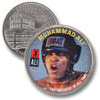
# CNS805 - Muhammad Ali - Boxing Helmet, US Kentucky Quarter
Olympic gold and a record three World Heavyweight Championship titles made Muhammad Ali a boxing legend. Outrageous rhetoric and memorable interviews made him a household name. And today, Ali’s humanitarian work – generously performed as he battles a crippling disease – makes him a respected figure on the world stage.
By the age of 18, Ali had already won more than 100 amateur bouts, two National Golden Glove Awards and a gold medal at the 1964 Olympic Games. It was an impressive start to the professional career that would capture our imaginations.
Ali won his first World Heavyweight Boxing Championship title in 1964 by defeating Sonny Liston. Young, brash and controversial, Ali seemed to reflect the unrest stirring across college campuses in the U.S. When he joined the Nation of Islam, changed his name from Cassius Clay to Muhammad Ali and refused to fight in the Vietnam War, many traditional boxing fans were outraged. Ali was stripped of his championship title... but not the talent that would soon gain the attention of boxing fans around the world.
On March 8, 1971, Ali entered the ring at New York’s Madison Square Gardens to take on World Heavyweight Champion Joe Frazier. Known as “Smokin’ Joe,” the unbeaten Frazier had a record of 26-0 with 23 knockouts. Ali was also unbeaten with a record of 31-0 and 25 knockouts, but he hadn’t fought a formidable opponent in a title match in years.
Madison Square Garden was like a circus the evening of the match. Hollywood stars, music legends and politicians packed the stands to watch Ali and Frazier battle for the largest purses (prize money) ever awarded for a single prizefight – $2.5 million each. Thousands more watched from closed-circuit televisions across America.
Ali dominated the first three rounds, but Frazier gradually tipped the scales in his favor and won by a unanimous decision. However, Ali earned the respect of the boxing world by going 15 rounds with a champion who had knocked out 23 other opponents and established himself as a contender who could draw record crowds.
Still, everyone was shocked when Ali regained his World Heavyweight title by defeating George Foreman, the heavily-favored champion, in “The Rumble in the Jungle.” Ali caused a frenzy with his unorthodox strategy of “dancing,” speed and a tactic dubbed “The Rope-A-Dope.”
Nearly a year to the day later, Ali pounded Joe Frazier in a 1975 rematch billed “The Thrilla in Manila.” The champ held the title until 1978, when Ali lost to Leon Spinks – and then quickly reclaimed the belt a few months later for a record third time.
Olympic gold and a record three World Heavyweight Championship titles made Muhammad Ali a boxing legend. Outrageous rhetoric and memorable interviews made him a household name. And today, Ali’s humanitarian work – generously performed as he battles a crippling disease – makes him a respected figure on the world stage.
By the age of 18, Ali had already won more than 100 amateur bouts, two National Golden Glove Awards and a gold medal at the 1964 Olympic Games. It was an impressive start to the professional career that would capture our imaginations.
Ali won his first World Heavyweight Boxing Championship title in 1964 by defeating Sonny Liston. Young, brash and controversial, Ali seemed to reflect the unrest stirring across college campuses in the U.S. When he joined the Nation of Islam, changed his name from Cassius Clay to Muhammad Ali and refused to fight in the Vietnam War, many traditional boxing fans were outraged. Ali was stripped of his championship title... but not the talent that would soon gain the attention of boxing fans around the world.
On March 8, 1971, Ali entered the ring at New York’s Madison Square Gardens to take on World Heavyweight Champion Joe Frazier. Known as “Smokin’ Joe,” the unbeaten Frazier had a record of 26-0 with 23 knockouts. Ali was also unbeaten with a record of 31-0 and 25 knockouts, but he hadn’t fought a formidable opponent in a title match in years.
Madison Square Garden was like a circus the evening of the match. Hollywood stars, music legends and politicians packed the stands to watch Ali and Frazier battle for the largest purses (prize money) ever awarded for a single prizefight – $2.5 million each. Thousands more watched from closed-circuit televisions across America.
Ali dominated the first three rounds, but Frazier gradually tipped the scales in his favor and won by a unanimous decision. However, Ali earned the respect of the boxing world by going 15 rounds with a champion who had knocked out 23 other opponents and established himself as a contender who could draw record crowds.
Still, everyone was shocked when Ali regained his World Heavyweight title by defeating George Foreman, the heavily-favored champion, in “The Rumble in the Jungle.” Ali caused a frenzy with his unorthodox strategy of “dancing,” speed and a tactic dubbed “The Rope-A-Dope.”
Nearly a year to the day later, Ali pounded Joe Frazier in a 1975 rematch billed “The Thrilla in Manila.” The champ held the title until 1978, when Ali lost to Leon Spinks – and then quickly reclaimed the belt a few months later for a record third time.











